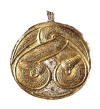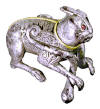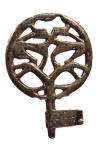|
Uppåkra
has a unique continuity regarding its long period of occupation. The first
traces can be dated to the Pre-Roman Iron Age, and the site was occupied
throughout the first millennium AD. The Iron Age in Sweden, 500 BC-1050 AD,
is divided into:
The
Pre-Roman Iron Age 500 BC-the Birth of Christ (also known as the Celtic
Iron Age)
The Roman
Iron Age the Birth of Christ-400 AD
The
Migration Period 400-550 AD (also known as Early Germanic Iron
Age)
The Vendel
Period 550-800 AD (also known as Late Germanic Iron Age)
The Viking
Age 800-1050 AD
During the
Roman Iron Age, the society changed and developed. Larger settlements became
small villages, and a high status class, an elite, emerged to rule over
extensive areas of land. Contacts with the Roman Empire could have inspired
the people up north to change and modernize their society. It is possible
that some Scandinavians were warriors in the Roman legions, and networks of
trade and exchange reached the Roman provinces. Several finds, mostly coins,
in Scania and also Uppåkra show direct or indirect contacts with the Roman
provinces. The settlement at Uppåkra started to grow during the Roman Iron
Age, and finds from this period onwards show a presence of both political
and religious power at the site. The first stage of a remarkable house with
a ceremonial function was founded around 200 AD. This house was rebuilt at
the same place until the early Viking Age. Local craftsmen worked with for
example bronze, antler and bone. Objects from foreign countries indicate the
beginning of a network of trade and exchange.
The
Migration period was turbulent in Europe because of the fall of the Roman
Empire. Groups of people were on the move, and objects from the former Roman
provinces spread even more than before. The presence of gold in Scandinavia,
both as objects and as raw material, was increasing during this period.
Uppåkra was a flourishing large village. Detector finds and excavations
indicate the function of a political and religious centre. Skilled craftsmen
produced different kinds of objects at the site, and
several objects also show long
distance contacts, mainly with the Continent. These functions and contacts
were to remain on a high level of importance until the end of the 900’s.
Many finds from the
Viking Age
show the established
trade,
both local and long distance. Uppåkra has for example one of the largest
Nordic prehistoric collections of weights.
During the
period when the settlement at Uppåkra was on its peak, it had several farms
with a structure that could have had some similarities with the early Middle
Age towns. A settlement with around 500-600 inhabitants, with an economy
based on agriculture, cattle breeding, trade and handi craft. Uppåkra is
interpreted as a central place, a regional centre. During the Late Roman
Age, some settlements started to show a complexity and a presence of
important functions, which have given them a definition of being central
places. Regarding Uppåkra, the size of the site, the quality and quantity of
finds, and the ceremonial building are all signs and examples of that
Uppåkra have had a major political and religious function with a
concentration of skilled craftsmen and trade.

The Uppåkra pendant, c 400 AD |

Helge, possible origin Western Europe,
late 8th early 9th century AD |

Viking Age bronze key
Staffanstorps nyckeln |
|